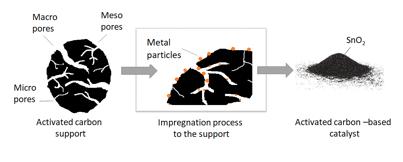When fiber sludge and spruce hydrolysates were used as the raw materials the best ethyl lactate yields were achieved again with the zinc containing catalyst. The results from the reusability experiments were also quite promising, since the zinc catalyst seemed to preserve its activity even after multiple cycles i.e. there was no noticeable decrease in ethyl lactate yields. More detailed information about the glucose and hydrolysate conversion to ethyl lactate can be read from the Kupila et al., 2021b (manuscript to be send for publication during spring 2021).
Glucose/fiber sludge conversion to biochemicals with homogeneous Brønsted and Lewis acids Glucose and fiber sludge were used as raw materials in production of biochemicals with homogeneous acid catalysts (Figure 13). The studied catalysts were sulfuric acid (H2SO4), which is a Brønsted acid, as well as SnCl2*2H2O and AlCl3*6H2O, which are Lewis acids (unpublished results). Selected results are given in Table 2. Based on the results, the homogeneous catalysts were not as efficient in lactic acid production than heterogenous carbon-supported metal oxide catalysts, even though there was the same active metal(s) present. The highest lactic acid yield, 30%, was achieved with glucose at 180 oC in 2 h with the pressure of 16 bars and with the mixture of SnCl2*2H2O and AlCl3*6H2O as the catalyst. When sulfuric acid was used as the catalyst, the reaction did not produce lactic acid as the product at all. Instead, levulinic acid was formed (Table 2). More detailed information about the fiber sludge conversion to levulinic acid can be read from the Lappalainen et al., 2019. Biomass Catalyst1 Glucose SnCl2*2H2O (32 mg) Glucose AlCl3*6H2O (16 mg) Glucose SnCl2*2H2O (8 mg) + AlCl3*6H2O (8 mg) Fiber sludge SnCl2*2H2O (32 mg) Fiber sludge AlCl3*6H2O (34 mg) Fiber sludge SnCl2*2H2O (8 mg) + AlCl3*6H2O (8 mg) Fiber sludge H2SO4 (0.3 M)
Reaction conditions Lactic acid yield (%) 180 oC, 2 h, 16 bar 15 o 180 C, 4 h, 16 bar 14 180 oC, 2 h, 16 bar 30 180 oC, 4 h, 16 bar 14 180 oC, 2 h, 16 bar 11 o 180 C, 2 h, 16 bar 16 180 oC, 1 h, 17 bar 491
Table 2. Biomass (55 mg) conversion to lactic acid in water (5 ml) with various homogenous catalysts 1 The formed biochemical was levulinic acid instead of lactic acid
1.4 WP1.3 Production of PLA from the obtained LA 1.4.1 METHOD The fermentation broths containing lactic acid that have been produced in WP1.1 have been used in polymerization trials with the aim to produce polylactic acid. For this purpose, different synthesis routes have been explored. The experiments have involved isolation of lactic acid from the fermentation broth through removal of water and unwanted salts followed by esterification and polymerization of pure lactic acid to PLA. There are various synthesis routes to produce PLA, among which are ring opening polymerization (ROP) of lactide and direct polycondensation. Both methods have been attempted during the project. However, although the ROP of lactide is commonly used in industrial production of PLA, we have not been able to produce larger quantities of PLA through this route. Instead, we have opted for polycondensation of lactic acid to PLA. This has involved purification of the crude lactic acid from the fermentation broth, esterification, oligomerization and finally polycondensation to produce polylactic acid.
14
GREEN BIORAFF SOLUTIONS








